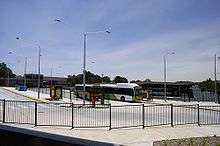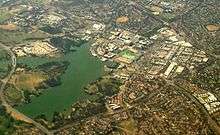Belconnen, Australian Capital Territory
| Belconnen Canberra, Australian Capital Territory | |||||||||||||
|---|---|---|---|---|---|---|---|---|---|---|---|---|---|
 | |||||||||||||
| Coordinates | 35°14′13″S 149°03′54″E / 35.237°S 149.065°ECoordinates: 35°14′13″S 149°03′54″E / 35.237°S 149.065°E | ||||||||||||
| Population | 4,437 (2011 census)[1] | ||||||||||||
| • Density | 1,008/km2 (2,612/sq mi) | ||||||||||||
| Established | 1983 | ||||||||||||
| Postcode(s) | 2617 | ||||||||||||
| Area | 4.4 km2 (1.7 sq mi) | ||||||||||||
| District | Belconnen | ||||||||||||
| Territory electorate(s) | Ginninderra | ||||||||||||
| Federal Division(s) | Fenner | ||||||||||||
| |||||||||||||

Belconnen (postcode: 2617) is the most inner suburb of the larger district of Belconnen in Canberra, Australia. Sharing its name with the larger district which encapsulates it, the suburb is surrounded with well developed infrastructure, and planning which allows it sunset views from the Brindabellas on its western side. The suburb contains important amenities for the District of Belconnen including the Belconnen Town Centre and Lake Ginninderra as well as its own well populated residential areas. It is bounded by Ginninderra Drive, Aikman Drive, Eastern Valley Way, Belconnen Way and Coulter Drive. It has a number of parks such as Margaret Timpson Park, (within the town centre) Eastern Valley Oval, (on the lower slope of Emu Ridge) and on the foreshores of Lake Ginninberra, Diddams Close Park and John Knight Memorial Park.
The name Belconnen has been associated with the district since the days of the early settlers. In the city of Canberra, suburbs are assigned street names that reflect a distinct sub-group of cultural or historical Australian significance. The streets in the suburb of Belconnen are named for Lord Mayors and Mayors.[2]
Features and location
Belconnen Town Centre is the major commercial centre for the Canberra district of Belconnen and is located in the suburb of Belconnen. Belconnen Town Centre includes the region's major shopping centre, Westfield Belconnen (known as Belconnen Mall),[3] large government office buildings including Cameron Offices, Australian Bureau of Statistics and Department of Immigration and Citizenship, and three bus stations.
The service and trades area is located in the suburb's west. In this area can be found car dealers and repairers, petrol stations, hardware stores, restaurants and many other specialty retailers.
Lake Ginninderra College, a secondary college for years 11 and 12, is located on Emu Bank, on the south-eastern shore of Lake Ginninderra.
Residential areas
Belconnen includes residential development areas, "Emu Ridge" in the south-east, "Ginninderra Heights" in the north-west and apartment buildings in Chandler and Beissel Streets.
Emu Ridge
Emu Ridge is bounded by Benjamin Way, College Street, Eastern Valley Way and Belconnen Way; Hennessy Street and Condell Street are the two main thoroughfares, with many cul-de-sacs off these. Emu Ridge consists solely of medium to high-density housing. Emu Ridge is often regarded as a suburb, mainly due to its distinct boundaries and because the name helps differentiate this part of the suburb from other parts of the suburb.
Ginninderra Heights
Ginninderra Heights was the name given to the medium-density residential development centred on Totterdell Street in the north-west of Belconnen.
Demographics
In the 2011 Census, the population of Belconnen was 4,437, including 57 (1.3%) Indigenous persons and 2,278 (51.4%) Australian-born persons.[1] 40.6% of the population was foreign born, the sixth highest for any Canberra suburb.[4] 52.3% of dwellings were units or apartments and 42.9% were semi-detached, row or terrace house or townhouses.[1]
Political representation
For the purposes of Australian federal elections for the House of Representatives, Belconnen is in the Division of Fenner.[5]
For the purposes of Australian Capital Territory elections for the ACT Legislative Assembly, Belconnen is in the Ginninderra electorate.[6]
Geology

Belconnen has the highest density of different kinds of rocks outcropping of any Canberra suburb. It is at the intersection of two faults that form an X shape across Canberra. These are the Deakin Fault and the Winslade Fault. Green grey rhyodacite of the Walker Volcanics is in the south along Belconnen Way. Deakin Volcanics purple rhyodacite is around the north end of Josephson St. Deakin Volcanics green grey and purple rhyodacite goes east from Lathlain Dr to Chandler St. Grey green dacite and quartz andesite Hawkins Volcanics is in a strip from the north west corner heading south east between two branches of the Deakin fault to around Chandler St and Hennessey St. A porphyry of Green-grey Dacitic intrusive containing large white Feldspar crystals is west of Eastern Valley Way and in between the two arms of Lake Ginninderra. Glebe Farm Adamellite intrusion is found to the south and east of Lake Ginninderra. Ordovician Pittman Formation greywacke is in the extreme south east and far north east of the town centre. Calcareous Shale from the Yass Subgroup is to the west of Lake Ginninderra. Dark grey and black laminated shale from the Acton Shale member is found on the west side of the Diddams Close Park in between the two arms of the lake.[7]
References
| Wikimedia Commons has media related to Belconnen, Australian Capital Territory. |
- 1 2 3 Australian Bureau of Statistics (31 October 2012). "Belconnen (State Suburb)". 2011 Census QuickStats. Retrieved 21 June 2012.
- ↑ "Suburb Name search results". ACT Environment and Sustainable Development. Retrieved 11 January 2013.
- ↑ Bacon, Erika (7 March 2014). "A weekend in your suburb: 36 hours in Belconnen". The Canberra Times. Fairfax Media. Archived from the original on 7 March 2014.
- ↑ "Where do migrants live? (4102.0 - Australian Social Trends, 2014)". Australian Bureau of Statistics. 17 March 2014. Retrieved 19 March 2014.
- ↑ "Profile of the electoral division of Fenner (ACT)". Current federal electoral divisions. Australian Electoral Commission. 8 February 2016. Retrieved 29 May 2016.
- ↑ "Electorates 2012 election". Electorates. ACT Electoral Commission. 5 July 2012. Retrieved 17 December 2013.
- ↑ Henderson, G. A. M.; Matveev, G. (1980). Geology of Canberra, Queanbeyan and Environs 1:50000 (Map).